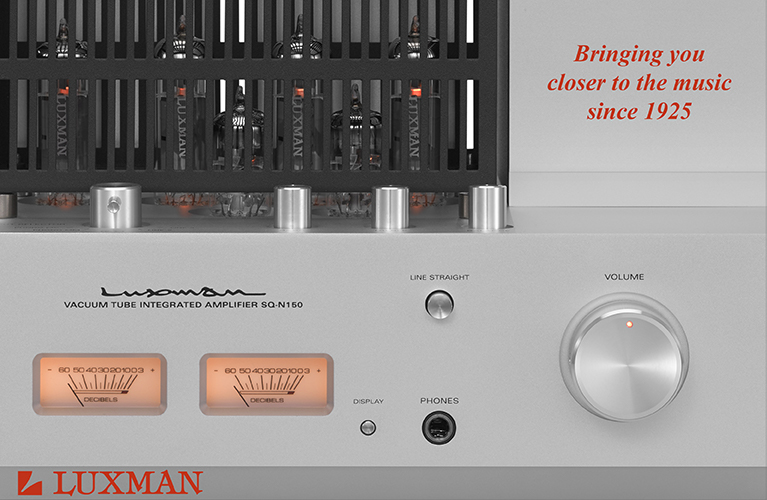I’m often the last stop for products that are sent to the SoundStage! Network for review. Normally, a review product is shipped direct to the assigned reviewer, who listens to it and writes it up, and then it gets shipped to me for photography and/or measurements. Typically, I also listen to a product before it goes back to the manufacturer or distributor, so I can get a feel for how it sounds.
One of the latest products we’ve reviewed is Bluesound’s new Powernode, which is priced at $949 (all prices in USD). The Powernode is a compact integrated amplifier running the BluOS music-playback software, with a built-in DAC; though, as you’ll read below, it’s not quite as simple as that. Gordon Brockhouse had the Powernode first because he reviewed it for SoundStage! Simplifi, but before his review went live he sent the amp to me so it could be photographed and measured. After we had finished those things, I decided to listen to the Powernode, so I connected it to the components that I’ve set up for my “System One” column. Not long after that, I knew I had to write about it in this column, too.
Background
Bluesound and BluOS are both owned by Lenbrook Industries, which also owns PSB Speakers and NAD Electronics. It’s a big, happy family of brands known for high performance and high value. But the brands differ in terms of what they offer.
The origins of NAD and PSB date back to the 1970s, so, not surprisingly, those brands are still rooted in traditional audio products—PSB’s bread ’n’ butter is still passive speakers, while for NAD it’s integrated and power amplifiers, preamplifiers, phono stages, audio/video receivers, and even turntables. But Bluesound and BluOS were founded in 2013, and, from the get-go, introduced products intended for music lovers who wanted good-quality sound, but who also valued compactness, high style, and sophisticated software-driven features.
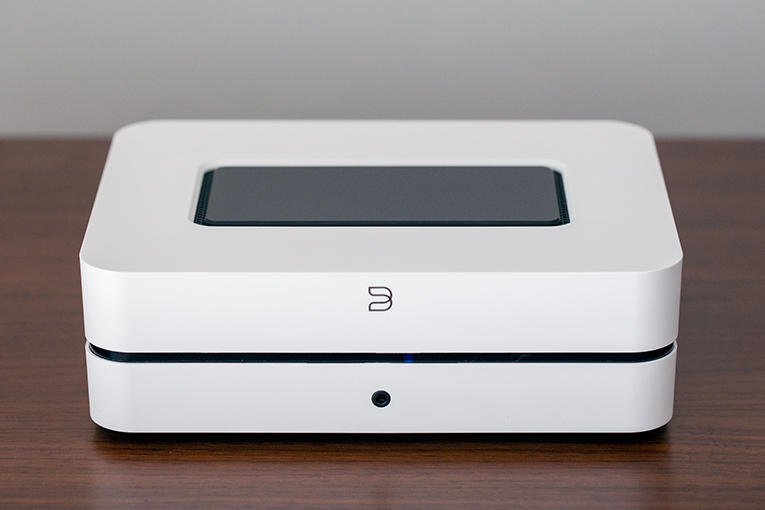
As a result, Bluesound currently offers its Pulse range of self-powered speakers, including the Soundbar+ soundbar and the Sub+ subwoofer; the Vault 2i CD ripper, streamer, and network-accessible hard drive; the Node streaming DAC ($599), which Gordon also reviewed for Simplifi; and the subject of this month’s column, the Powernode. I believe these last two are the company’s most popular products, and it’s not hard to see why.
Bluesound components are all based on BluOS, a multiroom music-playback system that’s compatible with or licensed to other companies’ electronics and active speakers—from NAD, of course, but also from Monitor Audio, DALI, Peachtree Audio, and Roksan, with more likely to come.
Description
Those who think the Powernode that I’m talking about has been around for years can be forgiven. The original Node—a streaming DAC that brought multiroom wireless streaming to a conventional hi-fi system—and Powernode debuted in 2013. They were subsequently upgraded and replaced by the Node 2 and Powernode 2, then by the Node 2i and Powernode 2i. But for this fourth iteration of the products, released earlier this year, Bluesound decided to chop off the suffixes and revert to the original names. It’ll be interesting to see what they call them if updated versions of these products appear in the future.
The Powernode has the same modern design aesthetic as the Node, and is available in matte white or matte black finishes. The case measures 8.7″W × 2.75″H × 7.5″D, and there’s a proximity-sensing touch panel on the top (that lights up as you approach it) with controls to adjust volume, select an input, change presets, and perform functions such as pause and track skip, among others.
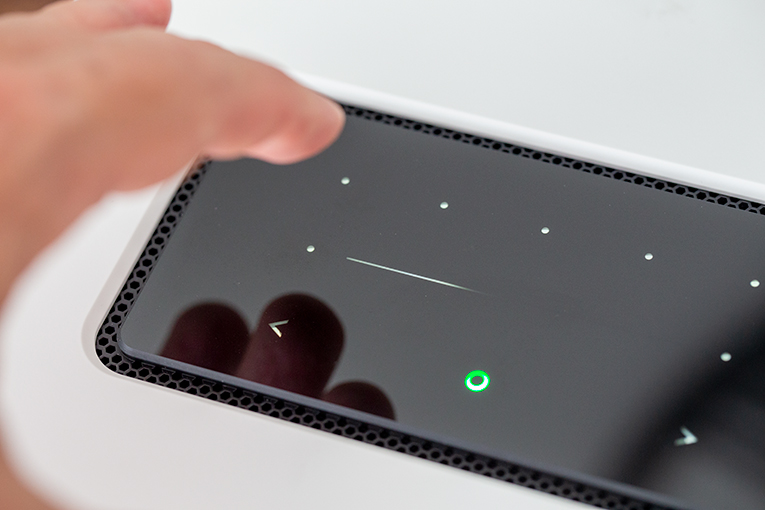
Under the hood, the Powernode has a built-in 32-bit/384kHz DAC and a digital volume control, and a class-D amplifier section capable of delivering 80Wpc into 8 ohms. According to Bluesound’s literature, the Powernode houses a “state of the art Quad-Core 1.8GHz ARM® Cortex™ A53 processor,” which is what’s used to run the BluOS software, as well as some of the other software-driven features.
On the backside, there are two pairs of screw terminals for connecting your speakers, and a single-ended RCA jack for a subwoofer. The sub output works in concert with BluOS, which lets you set the crossover frequency between 40 and 200Hz. Sounds above the crossover frequency are sent to the main speakers, while those below the crossover frequency are sent to the sub output.
There are two 3.5mm dual-purpose minijack inputs on the rear—if you connect an analog cable to a minijack, it’ll accept an analog signal, but if you connect a mini-TosLink cable it will accept a digital signal. The Powernode also has an HDMI ARC connector, an IR input, a USB Type-A port for connecting a storage device such as a hard drive or a thumb drive with music files, and an RJ45 Ethernet connector for network hook-up. For my review, I connected to my network via the built-in Wi-Fi.
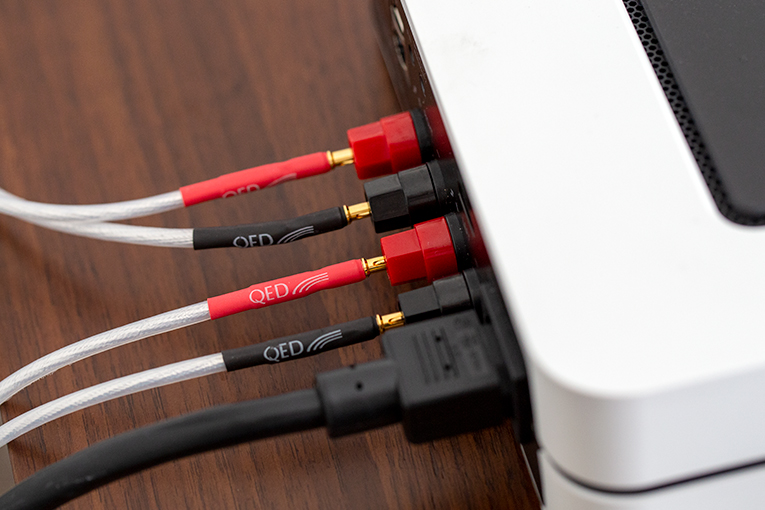
On the front of the Powernode there’s a 3.5mm headphone jack, which I must make a confession about—I forgot to use it before I sent the review unit back, so you won’t see any commentary about my experiences with headphones.
The Powernode doesn’t come with a remote control—that’s because it’s intended to be used with a tablet or smartphone running the BluOS Controller app, which, I must say, works really well. I don’t want to get too much into the software’s functionality because Gordon did a deep dive into its operation for both of his reviews, but I downloaded the BluOS Controller app to my Samsung Galaxy S20+ smartphone from the Google Play app store and used it to set up the Powernode on my network, assign Tidal as a streaming service, and play my first song, all in under three minutes.
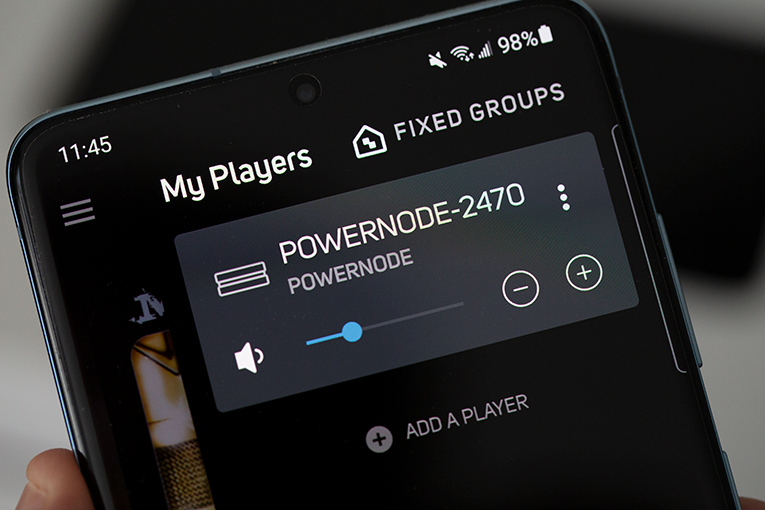
I wasn’t the only one who found the BluOS Controller app easy to use. My wife often streams music from Tidal to this stereo system, so I had her install the BluOS app on her phone. She had it up and running and playing music in just a few minutes, and found it just as intuitive as Tidal’s app.
While I was setting up the app, I also noticed that it supports a plethora of streaming services besides Tidal—such as Spotify, Qobuz, Amazon Music HD, and Deezer—and can be configured to access internet-based radio stations, podcasts, and more. The Powernode is also Spotify Connect and Tidal Connect compatible, so it’ll work directly with the apps for those streaming services. I’m no expert on streaming software, but Gordon is. In his review of the Node, which runs the same software, he wrapped up his assessment by saying: “BluOS is a rich platform, with many functions, but it’s also well designed. Users who are new to streaming can expect to face a learning curve. What they won’t experience is tear-your-hair-out frustration.” I agree.

Setting up and listening
I first used the Powernode with a pair of KLH Audio Albany II speakers ($299.99/pair), which I wrote about in September. Truth be told, it was a little weird setting this system up.
The components I write about in my “System One” column are in a room that’s 19′ long by 15′ wide; the ceiling is 8′ high. The components are set up along one of the shorter walls. I put the speakers on 24″ Monoprice Monolith stands ($109.98/pair), connected them to the Powernode with QED XT25 speaker cables ($84.99/2m pair, discontinued), and plugged the Powernode into the power outlet with the skinny power cord it’s supplied with. That was it—which is what I found so weird. I’m used to having to connect so much more stuff for a complete system. Then, as I’ve already mentioned, I downloaded the BluOS Controller app and had everything working within a few minutes. Easy-peasy—and the Powernode took up no more space on my cabinet than a hardcover book lying on its side.
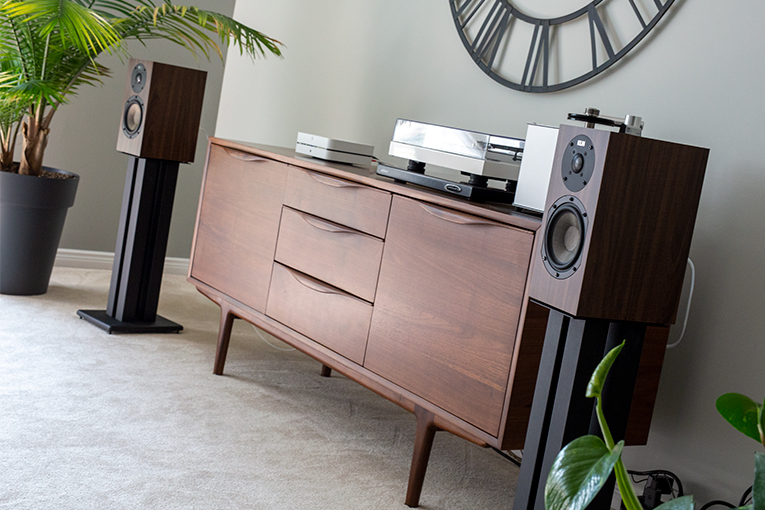
That said, I found one deficiency of the Powernode as I was setting it up—it’s not as easy to use it with a turntable as, say, NAD’s integrated amplifiers, which usually have a built-in phono stage. The Powernode doesn’t have a phono stage, but neither does it have “proper” RCA inputs to connect one. Instead, it has two 3.5mm minijack inputs which you can use for an external phono stage, but you’ll need an RCA-to-minijack adapter to make it work. That should work fine, but seems a bit kludgy, which is why I didn’t do it. So you should know that the Pro-Ject Audio Systems X1 turntable that you see in some of the accompanying photos wasn’t in use this time.
That lack of turntable support is, I believe, by design. Bluesound seems to be a company that focuses on digital streaming—something this product does exceedingly well. As I mentioned, from initial setup to playing music was just a few minutes. And in the weeks that followed, my wife and I played hundreds of tracks and we never experienced a streaming hiccup even though the Powernode was connected to my network via Wi-Fi, which is typically slower and more unreliable than a wired connection. I was surprised how well it worked.
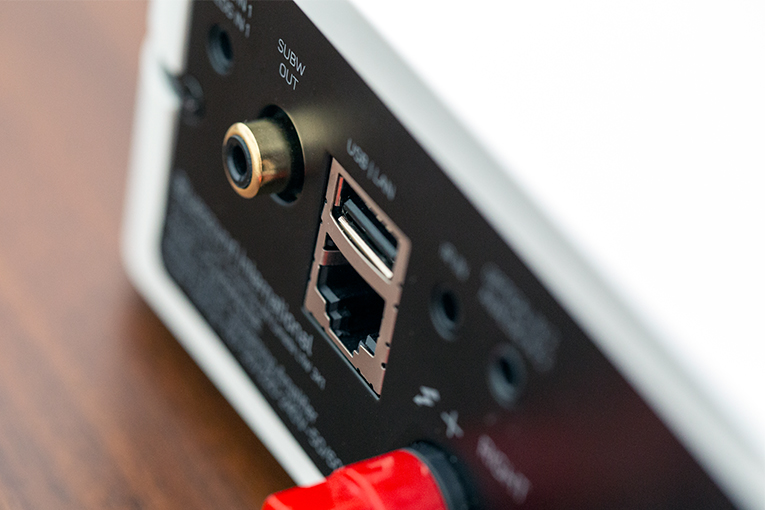
The sound quality was also surprising. In my review of the Albany IIs, I reported that when I played Lana Del Rey’s Chemtrails Over the Country Club (16-bit/44.1kHz FLAC, Interscope Records/Polydor Records/Tidal), the midrange sounded “super-clear and surprisingly realistic, especially when reproducing vocals.” I also wrote: “When I played Van Morrison’s ‘Spanish Steps,’ from Poetic Champions Compose (16/44.1 FLAC, Mercury Records/Tidal), which he released in 1987, the sound of his sax soared into my room with almost all the breathy detail I could ask for.” These statements were written in the context of what I was hearing from the speakers, but the Powernode was what was driving them, so credit must go there as well.
I also said in that article that the Powernode “provided more than enough power for the Albany IIs,” but one thing I couldn’t suss out with those speakers was the bass performance of the amp, because the speakers don’t output much bass. So I wrote that when I played “Dark but Just a Game,” from Chemtrails Over the Country Club, “I could only hear a few upper-bass grunts from the speaker, but nothing below, say, 80Hz.” When I reflect now, 80Hz might’ve been optimistic for those speakers—extension to just 90 or 100Hz might be more realistic.
To learn more about the Powernode’s bass performance for this write-up, I removed the Albany IIs and set up a pair of PSB Synchrony B600 loudspeakers on their matching stands in the same places on the floor. Priced at $2499 per pair, plus another $499 for the stands, these speakers are probably more expensive than anyone who buys the Powernode will consider partnering it with, but set up well in a room, the B600s have absolute killer bass output for standmount speakers—both in depth and power. They also allowed me to hear how the amp would perform with higher-end speakers.
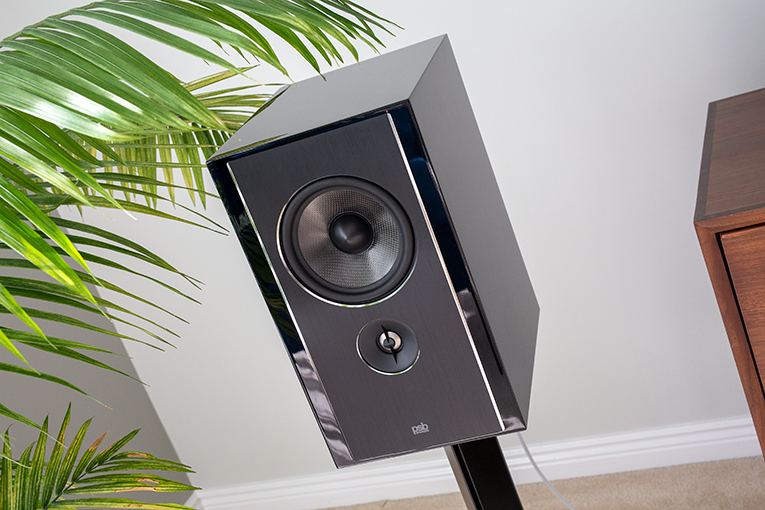
When I played “Dark but Just a Game” through the PSBs, the super-deep bass that’s in the recording was reproduced in my room in spades. Another song that sounded bass-light through the Albany IIs was Bruce Cockburn’s “Pacing the Cage,” from his album The Charity of Night (16/44.1 FLAC, True North Records/Tidal), which he released in 1996. Through the Albany IIs, the robustness of Cockburn’s acoustic guitar was lacking, while the sound of Rob Wasserman’s bass guitar was basically absent. But with the Powernode driving the PSBs, all that low bass was back.
This product pairing also taught me that even though the B600s are much more expensive than the Powernode, using them together wasn’t such an outrageous idea—because the Powernode wasn’t outclassed by the loudspeakers. Once again, it provided more than enough power for all the listening that goes on in this room in my house. That includes my wife listening to playlists of Latin music at high volume on house-cleaning day. I’m talking about volume levels such that the music can be heard in every room in the house, and high enough that the stereo can overcome the roar of the vacuum cleaner.
The sound quality from the system also took a significant step up with the B600s. For example, when I played “Pacing the Cage,” I heard quite a bit more detail in Cockburn’s singing voice than I had through the Albany IIs. The sound of his guitar was also better defined within the mix. I also heard better sound from Chemtrails Over the Country Club, as well as from every recording I played through the speakers. Chalk that up mostly to the PSB Synchrony B600s—but know that it was the Powernode driving them.

But that’s not to say that the Powernode is the be-all and end-all for powering speakers like these. Right now, as I’m typing this, I have the B600s in the same spots on the floor, but now they’re hooked up to a Kinki Studio EX-M1+ integrated amplifier. It’s just an integrated amplifier—meaning it has no DAC, nor does it have a built-in phono stage. So I also added a Denafrips Ares II DAC, which receives music wirelessly from Tidal via a Chromecast Audio streamer connected to one of its TosLink inputs. The Kinki Studio and Denafrips combo sells for about $3700 (I used the word about because they’re sold through Vinshine Audio, which is located in Singapore, in Singaporean currency, which I converted to US funds as I wrote this), while the Chromecast Audio sold for $35 when it was available, plus $10 for the mini-TosLink. AudioQuest Chicago interconnects attach the Denafrips to the Kinki, so tack on another $95 to the system cost.
With this setup, I can now hear a slightly cleaner and a more effortless sound compared to when the Powernode was in the picture. I think the effortlessness has to do with the Kinki’s higher power—almost 200Wpc into 8 ohms. Higher-powered amps almost always seem to sound more effortless than lower-powered ones, even when you’re not using all that much power.
Yet the Powernode isn’t all that far behind when it comes purely to sound quality—it might lack some effortlessness with these speakers, but it sounded almost as clean and detailed as the Kinki and Denafrips combo. And I do mean almost—we’re not talking about big differences here, like we are when it comes to the differences in their prices. After all, the Powernode costs about one-quarter of the total price of the other components. What’s more, the onboard BluOS software is much more sophisticated and better integrated into the operation of the Powernode than the Google Home app, which governs Chromecast Audio streaming from a device such as a smartphone.
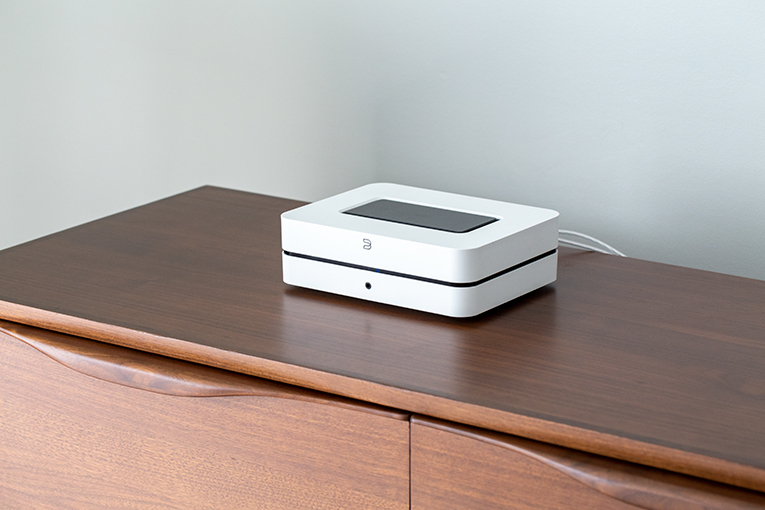
As a result, I think that anyone who buys a Powernode now and uses it with inexpensive speakers will be perfectly happy with everything it offers in terms of sound quality and functionality. And if they upgrade to even better speakers, the Powernode won’t be much of a limiting factor for the sound. So consider the Powernode to be a product that a music lover can grow with. Once again, my findings fall in line with something Gordon Brockhouse stated in his Powernode review: “Sonically, I think it delivers a lot for its asking price. And functionally, the Powernode delivers a ton.”
Conclusion
Bluesound’s Powernode delivers enough clean power to drive typical home speakers, but outside of that, it’s not like your average integrated amplifier-DAC. With just two dual-purpose (digital or analog) 3.5mm inputs, it lacks the connectivity options of most integrated amps, and without a phono stage or RCA input jacks, it’s not as turntable friendly as, say, one of the integrated amps from sister-brand NAD. It also doesn’t look like a high-end audio component—it’s small and, from an industrial-design perspective, unlike offerings from any other hi-fi company.
But that look is purposeful; Bluesound has positioned the Powernode with a feature set that appeals to digital-media-streaming consumers who just want to add speakers and not fuss with anything else. To that end, the Powernode is the bomb, and no wonder it’s been a popular product for Bluesound—and one the company has continued to improve with subsequent versions. A product that’s this useful and this well priced deserves to live on and on. So if it fits your lifestyle and listening needs, I encourage you to try a Powernode and see if you agree. For $949, the Powernode is a brilliant example of affordable, compact, modern hi-fi design that’s as easy to live with as it is to listen to.
. . . Doug Schneider
das@soundstagenetwork.com






















